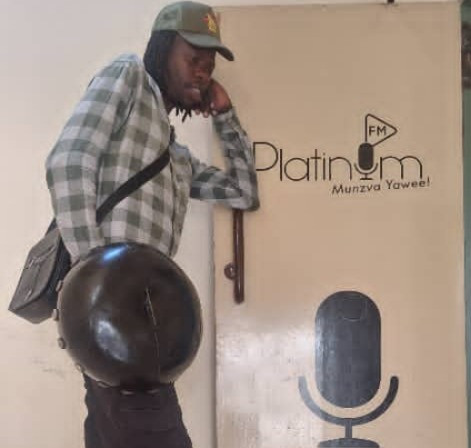
INTERNATIONALLY-RENOWNED visual artist Patrick Makumbe has a rare talent of being able to demonstrate how art can help society to see.
One of his paintings could have just been a plain head and shoulders portrait attracting mild interest.
By a stroke of genius — a small detail of red lipstick smudged on the forehead of the male subject draws attention, provokes curiosity and brings a deluge of speculations about the picture.
Makumbe, a contemporary artist living and working in Zimbabwe, is an alumnus of the former BAT Visual Art Studios (now the National Gallery School of Visual Arts and Design) at the National Gallery of Zimbabwe.
In 2005 he was in residency at the Rijksakademie in Amsterdam, where fellow Zimbabwean artists Admire Kamudzengerere and Gareth Nyandoro were also enrolled in 2012 and 2014,respectively.
Makumbe is currently in a solo show at First Floor Gallery Harare. The title of the exhibition Kuva Ziso, which in Shona means to be the eye, reveals how the artist takes his vocation as a social responsibility and civic duty.
Makumbe paints in the style known as expressionism, which is characterised by random choice of colours and striking or shocking compositions, formulating a personal interpretation of objects and events.
In expressionism, the subject is usually distorted to express emotion and evoke moods. Expressionists strive to depict the world as it feels, instead of showing only what it looks like. Established between 1905 and 1920 in Germany, the expressionist movement was a reaction to impressionism, an earlier movement which emphasised presentation of the physical appearance of objects.
- Makumbe shares gift of seeing through art
Keep Reading
In their work, expressionists are concerned with personal feelings aroused through distortion and exaggeration of the subject.
According to the art historical canon, expressionists turned away from naturalism as a direct influence from African art in which abstraction of the human figure and use of dissonant colours are used to convey emotional and psychological depth.
Protagonists of expressionism derived their inspiration from traditional masks and sculptures made by African tribes.
Makumbe approaches his work in terms of space, colour and shadow. He describes the outcome as a conversation, silence and solitude.
“I don’t focus on the face,” he says. “I am more deeply moved by body language and action.”
A typical example of the artist’s talent was the crowd favourite at the opening of the exhibition. Unlike other pieces in the show the artwork’s title appeared to have been accidentally omitted. This created a perfect occasion for the audience to respond to the content without influence from suggestive text.
The popular artwork depicted a balding middle-aged black man wearing a blue formal jacket over a white shirt and brown necktie.
Positioned dead centre of the frame with uninteresting opaque gray background, the man in a blue jacket could be a white-collar worker, manager or businessman. The “kiss” on the man’s forehead suggests that he was coming from a formal event and passed through a recreational joint.
In Harare, Bulawayo, Mutare and elsewhere in Zimbabwe the weekend draws men to various places of entertainment. The man in a blue jacket may have been at a fancy bar or open-air leisure centre. Having established his movements, it can fairly be assumed that it is late evening on a Friday.
The scarlet lips stamped on the subject’s forehead tell the viewer that the man has been socialising with some mysterious female company.
The fact that a woman has been erased from the picture may imply that they are not formally related. A self-satisfied smirk on the man’s face attempts to hide the secret but the evening’s guilty pleasures are evident to all.
At this point, the viewer might assume that the subject is inebriated, is suffering from impaired judgment, and is going to walk into trouble as soon as they get home. Two questions will guarantee that; Where have you been? Who were you with?
Unfortunately, for the fellow in a blue jacket, typical evasions will not save the day because this time he will be caught “red-handed” so to speak.
Drama is about to unfold and it will be comical when he tries to explain what happened to his forehead. What is interesting about this painting is that the artist does not relish the conflict about to ensue, so he deliberately avoids getting there.
Makumbe does not condone the man's behaviour, which he leaves for the viewer to judge and speculate over. At first it may seem as if the man in the blue jacket is a stereotypical male philanderer, in which case both the absent women would be his victims.
The deliberately planted pouting lips, however, can be read as an empowered gesture from an individual who is not a passive participant. It would be different if evidence of the kiss was left on a more submissive position such as the cheek, chin or collar.
Instead of showing patriarchy having its day, the painting might suggest that the man has been played for a sucker. From where the viewer stands, one can sense that the spouse or girlfriend will not be easily fooled or tolerate the misadventure.
The scandal is compounded by the man’s receding hairline,which can be taken as a sign that he is long past the age for these shenanigans.
The pleasure in Makumbe’s art comes from being able to tell many stories from a static image. It is interesting that all of the above scenarios did not arise from explicit suggestions made by the artist, but are subjective interpretations invoked by space, colour and composition.










